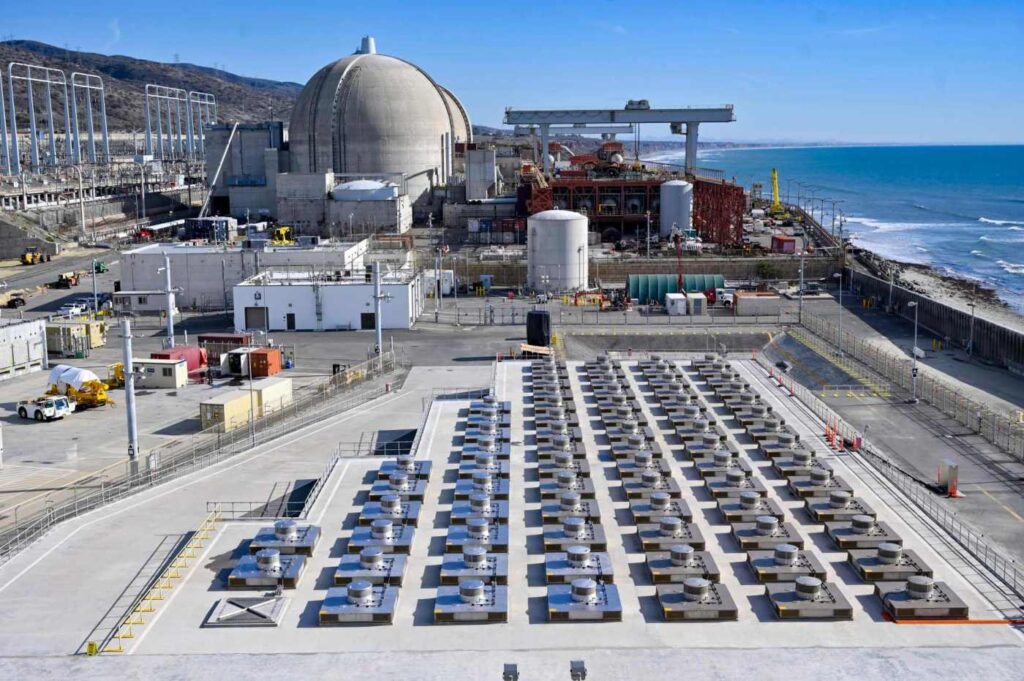
In Finland, a permanent repository for spent nuclear waste is licensed and under construction.
In Sweden, the government has given its blessing to a final resting place. France has identified a site, Canada is in the final stages of choosing one, Japan and Switzerland have started geologic and other investigations.
The U.S., meanwhile, has been unable to agree on even a temporary home — much less a permanent one — for the 190 million pounds of highly radioactive waste piling up at commercial nuclear reactors all over the nation.
“They’re smarter than we are,” said Tom Issacs, a nuclear expert who was lead adviser to the Blue Ribbon Commission on America’s Nuclear Future. “They understand we had science and technology better than anyone — but building trust and confidence, that we didn’t have.”
Commercial nuclear waste is scattered all over the country. SOURCE: NUCLEAR ENERGY INSTITUTE
Issacs addressed the San Onofre Community Engagement Panel’s quarterly meeting on Thursday, Feb. 10, as federal officials brought folks up to speed on its latest push to create centralized, community-embraced, temporary storage sites, while the prickly issue of permanent storage is parsed.
Nations that have been able to find homes for the waste did three simple things that the U.S. has not done, Issacs said: They understood if someone is going to trust you, they must believe you’re competent, and that you have their best interests at heart, and that they’ll be better off for being part of the process.
“You listen, and respond,” Issacs said. “It doesn’t mean, ‘I understand this better than you, listen to me, I’m a scientist.’ It’s, ‘If you’re concerned, I’m concerned.’ That’s the key in a nutshell to why things work in Sweden and Finland and hopefully in Canada,” which is to finalize its site next year.
And that, said Kim Petry, acting deputy assistant secretary of spent fuel and waste disposition for the U.S. Department of Energy, is precisely what the federal government is trying to do.
Finding host communities
In November, the DOE announced a fresh push to find communities interested in hosting consolidated temporary storage. It’s collecting thoughts on how to do that fairly and equitably at consentbasedsiting@hq.doe.gov. Responses must be received by 2 p.m. Pacific Time on March 4.
The DOE is not seeking community volunteers just yet, but will launch that effort later this year along with a “funding opportunity,” Petry said.
Nuclear energy is an essential part of the nation’s clean-energy plan, but the U.S. can no longer ignore the conundrum at the back end of the fuel cycle, she said. The DOE’s failure to meet its contractual obligation — to start collecting spent fuel from nuclear reactors in 1998 for permanent disposal — already has cost taxpayers $9 billion in settlements and judgments won by utility companies that are stuck with the stuff and have had to build and secure storage facilities on site.
Communities like the ones around San Onofre — where 3.6 million pounds of nuclear waste are entombed in concrete on a quake-prone coast just feet from the ocean — never agreed to host the material long-term, Petry said. “We can’t continue to defer this for future generations to figure out.”
The problem is a political, not a technical, one.
Southern California Edison’s media relations manager, John Dobken, shows simulated nuclear fuel pellets like the ones stored inside canisters at San Onofre’s dry fuel storage facility. (Photo by Mindy Schauer, Orange County Register/SCNG)
“(W)e know what we have to do, we know we have to do it, and we even know how to do it,” said the Blue Ribbon report, now 10 years old. “Rather the core difficulty remains what it has always been: finding a way to site these inherently controversial facilities … in a manner that allows all stakeholders, but most especially host states, tribes and communities, to conclude that their interests have been adequately protected and their well-being enhanced — not merely sacrificed or overridden by the interests of the country as a whole.”
‘We’re really behind’
After the contentiousness of Yucca Mountain, the temporary storage effort was kicked off under the Obama administration, suspended under President Donald Trump, and returned under President Joe Biden.
The fickleness of philosophy and funding from one administration to the next is part of the paralysis, but Congress can and must fix that with legislation, speakers said.
“We have to be able to make and keep commitments,” Issacs said.
Funding for the effort in this fiscal year is $27.5 million, a tiny trickle in the department’s $46 billion budget. More, and more stable, funding will be required to make consolidated storage happen, said John Kotek of the Nuclear Energy Institute, a trade group.
David Victor, a professor at UC San Diego and chair of San Onofre’s volunteer Community Engagement Panel, was impressed with how rapidly the effort is coming together — but noted that the U.S. has a lot of catching up to do.
“Frankly, we’re behind,” he said. “We’re really behind.”
More than 150 people attended the online meeting.
“Consent-based siting focuses on the needs and concerns of people and communities,” Petry said. “By prioritizing communities and people, we believe we can find a solution to the decades-long stalemate on managing the nation’s spent nuclear fuel. It’s both the right thing to do, and our best chance for success.”
Related Articles
DOE official to provide update on push to find home for nuclear waste
